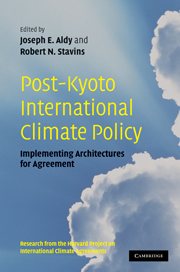Book contents
- Frontmatter
- Contents
- Harvard Environmental Economics Program, International Advisory Board
- Harvard Project on International Climate Agreements, Faculty Steering Committee
- Harvard Project on International Climate Agreements, Project Management
- List of figures
- List of tables
- List of contributors
- Foreword
- 1 Introduction
- Part I Alternative international policy architectures
- Part II Negotiation, assessment, and compliance
- Part III The role and means of technology transfer
- Part IV Global climate policy and international trade
- Part V Economic development, adaptation, and deforestation
- Part VI Modeling impacts of alternative allocations of responsibility
- 23 Modeling economic impacts of alternative international climate policy architectures: a quantitative and comparative assessment of architectures for agreement
- 24 Sharing the burden of GHG reductions
- 25 When technology and climate policy meet: energy technology in an international policy context
- 26 Revised emissions growth projections for China: why post-Kyoto climate policy must look east
- 27 Expecting the unexpected: macroeconomic volatility and climate policy
- Part VII Synthesis and conclusion
- Appendix A Selected List of Individuals Consulted, Harvard Project on International Climate Agreements
- Appendix B Workshops and Conferences, Harvard Project on International Climate Agreements
- Glossary and Abbreviations
- Index
23 - Modeling economic impacts of alternative international climate policy architectures: a quantitative and comparative assessment of architectures for agreement
Published online by Cambridge University Press: 05 June 2012
- Frontmatter
- Contents
- Harvard Environmental Economics Program, International Advisory Board
- Harvard Project on International Climate Agreements, Faculty Steering Committee
- Harvard Project on International Climate Agreements, Project Management
- List of figures
- List of tables
- List of contributors
- Foreword
- 1 Introduction
- Part I Alternative international policy architectures
- Part II Negotiation, assessment, and compliance
- Part III The role and means of technology transfer
- Part IV Global climate policy and international trade
- Part V Economic development, adaptation, and deforestation
- Part VI Modeling impacts of alternative allocations of responsibility
- 23 Modeling economic impacts of alternative international climate policy architectures: a quantitative and comparative assessment of architectures for agreement
- 24 Sharing the burden of GHG reductions
- 25 When technology and climate policy meet: energy technology in an international policy context
- 26 Revised emissions growth projections for China: why post-Kyoto climate policy must look east
- 27 Expecting the unexpected: macroeconomic volatility and climate policy
- Part VII Synthesis and conclusion
- Appendix A Selected List of Individuals Consulted, Harvard Project on International Climate Agreements
- Appendix B Workshops and Conferences, Harvard Project on International Climate Agreements
- Glossary and Abbreviations
- Index
Summary
This chapter is part of the research work being carried out by the Climate Change Modeling and Policy Research Programme of the Fondazione Eni Enrico Mattei and by the Climate Impacts and Policy Division of the Euro Mediterranean Center on Climate Change. The authors are grateful to Rob Stavins, Joe Aldy and the Harvard Project on International Climate Agreements for many helpful comments and enduring support. William Nordhaus and participants to the 3rd Atlantic Workshop on Energy and Environmental Economics also provided precious comments and suggestions. The collaboration with Scott Barrett, Jeff Frankel and David Victor has been fundamental for the successful development of the research project whose results are presented in this chapter. Any remaining errors are the authors’ sole responsibility.
Introduction
According to the latest report of the Intergovernmental Panel on Climate Change (IPCC) there is unequivocal evidence that the climate system is warming, which is expected to affect both ecosystems and socio-economic systems to varying degrees (IPCC, 2007). Changes in atmospheric concentrations of greenhouse gases (GHGs) are deemed responsible for the observed increase in average global temperature, which has risen by 0.76°C since 1850—mostly in the last fifty years. The IPCC also points to widespread agreement in the scientific community that such changes in the climate system may be spurred by global GHG emissions from human activities, which increased by 70 percent between 1970 and 2004. If emissions continue unabated, the Earth's average global surface temperature is likely to rise by a further 1.8°C −4.0°C this century (IPCC, 2007).
- Type
- Chapter
- Information
- Post-Kyoto International Climate PolicyImplementing Architectures for Agreement, pp. 715 - 752Publisher: Cambridge University PressPrint publication year: 2009
- 3
- Cited by



